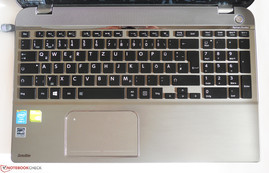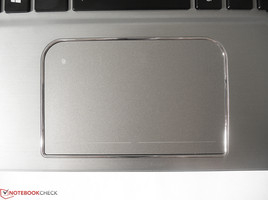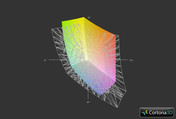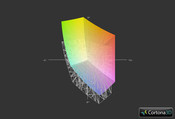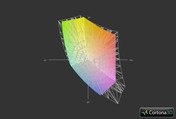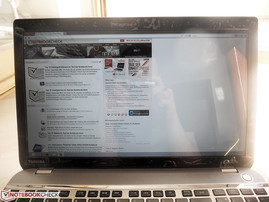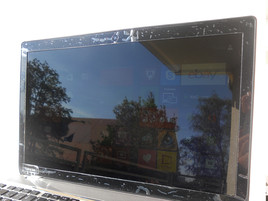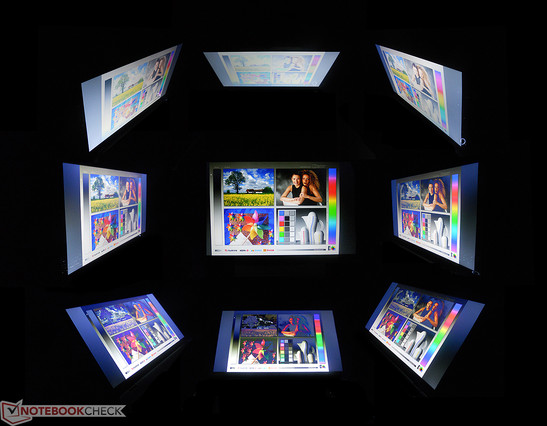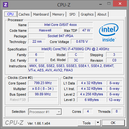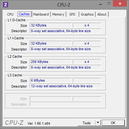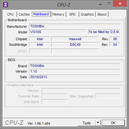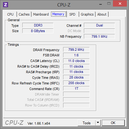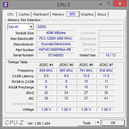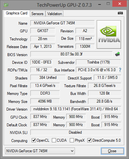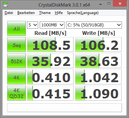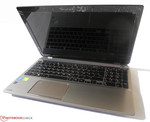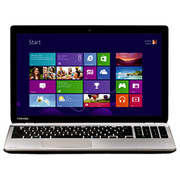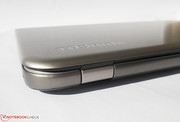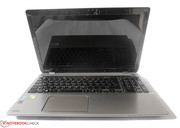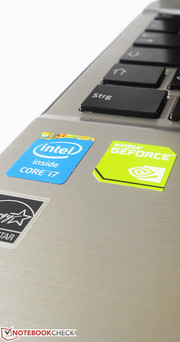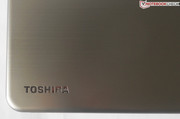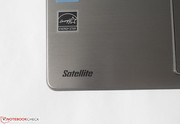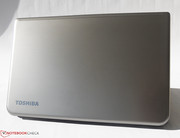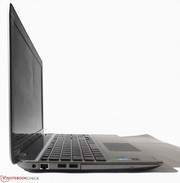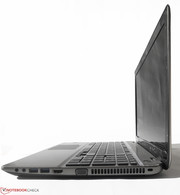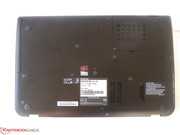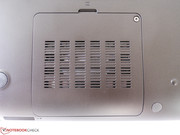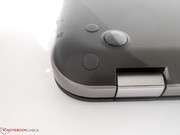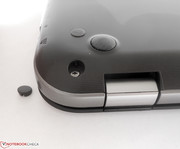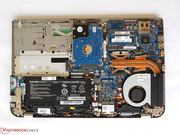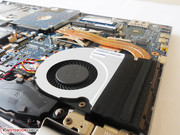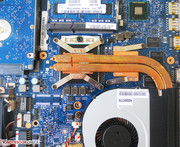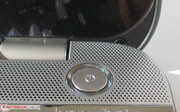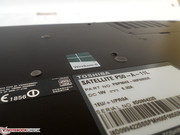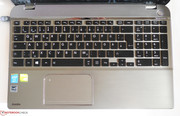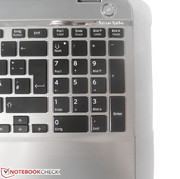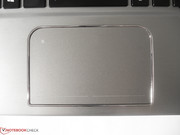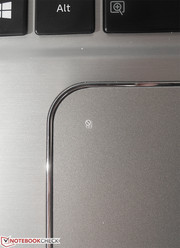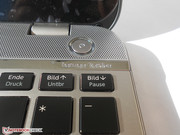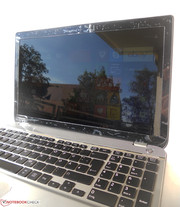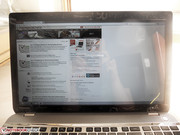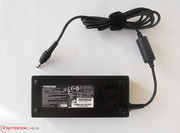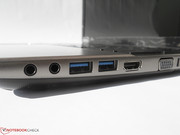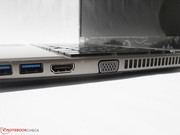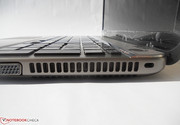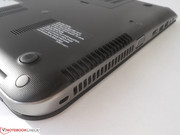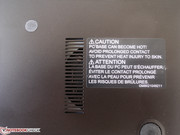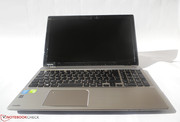Review Toshiba Satellite P50-A-11L Notebook
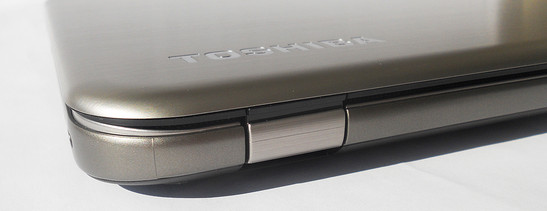
For the original German review, see here.
After we just recently reviewed two 17.3-inch multimedia notebooks with the Satellite L70-A-10T and the S70-A-10F, the Japanese manufacturer Toshiba now sent us the 15-inch Satellite P50-A-11L for an in-depth review.
Competitors for the silver aluminum device are the popular price-performance champion Acer Aspire V5-573G-74508G1Takk, the touch-ultrabook VivoBook S551LB-CJ026H and the very powerful Lenovo IdeaPad Y510p.
But does the Toshiba Satellite P50-A-11L have to hide behind the competition? Not at all, the 25 mm thin notebook is equipped with a current Intel Core i7-4700MQ (Haswell) as well as a powerful Nvidia GeForce GT 745M with generous 4096 MB DDR3 video memory. All that is supported by 8 GB DDR3 (1600 MHz) dual-channel memory and data can be stored on the 5,400 rpm HGST Travelstar 5K1000 hard drive.
Case
The manufacturer really put a lot of effort into the case of the Satellite P50-A-11L: Silver, brushed aluminum on the display cover and the base unit (palm rest and keyboard bezel); the metal not only leaves a noble impression but also has high quality feel with its cool haptics.
However, the case is not completely made of aluminum, even though the silver plastic on the sides, on the hinges and the plastic speaker grilles would suggest it. The bottom cover is also made of matte black plastic and does leave a solid impression without reducing the overall quality.
Don't be fooled by the use of aluminum, you should not expect the quality or stability of a MacBook, for example. The display cover is not very torsion-resistant despite the aluminum, even though it is still average for this notebook class. There is not much criticism with the base unit; we can hardly twist it and the keyboard does not show any signs of flexing. The hinges do a good job and keep the display well in position but you can still open the cover with one hand. They could be slightly firmer when the display cover is closed, but this is a common problem for notebooks.
All in all, the P50-A-11L is a typical notebook with a solid build quality and a noble impression because of the aluminum.
Connectivity
The port selection of the Toshiba Satellite P50-A-11L includes common ports for a multimedia notebook. Our only criticism concerns the port layout. Especially the fan exhaust at the back of the right side is not ideal if you use an external mouse with your right hand. The right side is also very crowded with VGA, HDMI, two USB 3.0 ports as well as the stereo jacks and could result in some cable chaos. There are no ports at the back because of the hinge construction; the card reader (multi) and some status LEDs are at the front.
Communication
Besides the mandatory Ethernet port (Atheros L1C PCI-E), the P50-A-11L is also equipped with an Intel Centrino Wireless-N 2230 WLAN module for wireless networks. We did not have any problems with the wireless signal in our test. We had a strong connection with a short distance and also with 8 meters and three walls in-between (4-5 bars).
Accessories
There are not many accessories in the box. Besides a short manual and a quick-start guide there is only a 120 Watts power supply unit.
Maintenance
Similar to many other notebooks, maintenance is not a very important aspect for the Satellite P50-A-11L. Only the system memory can be accessed via a small maintenance cover. Several rubber feet hide all the screws that secure the bottom cover. You will have to ask the manufacturer if you lose the warranty when you open this cover. We collected further information in a special article.
Warranty
Toshiba grants a 24-month manufacturer's warranty with an international bring-in service ex-works. The coverage of this international service depends on your country. The manufacturer also offers a pick-up-and-return service in some countries after you register your device with Toshiba's notebook hotline (Germany and Austria).
Input Devices
Keyboard
Toshiba equips the Satellite P50 with a black chiclet keyboard. Apart from the unusual layout with different key spacing and key groups as well as the small space bar, we really like the large size of the keys. The manufacturer uses the complete width of the base unit and integrates a clear keyboard with a separate numeric keypad. The typing experience is also okay, we just did not like the soft and slightly bouncy key stroke. We would have preferred a more precise and more defined feedback. However, even longer typing sessions are no problem with the Toshiba Satellite P50-A-11L. A convenient and stylish background illumination (not adjustable) completes the good impression.
Touchpad
The touchpad, however, which is integrated at an angle in our review unit, cannot quite keep up with the quality of the keyboard. It is generously sized with 11 x 7 cm but it does not have dedicated mouse buttons. Combined with the bad support for multitouch gestures and the bad driver it does not result in the best experience. It is quite often that common gestures like two finger scrolling are not recognized at the first time and Windows 8 gestures do not improve the situation either. The overall usability of the mouse replacement is okay, but we do recommend an external mouse if possible.
Display
Toshiba equips the Satellite P50-A-11L with a TruBrite® Full HD LED Backlit Display. This is quite a designation, but can the notebook display convince us in regard to the quality?
A look at the specifications shows that we probably should not expect too much. But one thing at a time: The TN panel AUO B156HTN03.0 has a super sharp resolution of 1920x1080 pixels (Full HD) and a glossy display surface, which creates visible and annoying reflections in bright environments. The term TruBrite is not really appropriate with an average brightness of just 193 cd/m²; the brightness distribution of 87% is okay. This also confirms our subjective impression; we cannot see any deviations or screen bleeding.
| |||||||||||||||||||||||||
Brightness Distribution: 87 %
Center on Battery: 190 cd/m²
Contrast: 556:1 (Black: 0.34 cd/m²)
ΔE ColorChecker Calman: 13.41 | ∀{0.5-29.43 Ø4.81}
ΔE Greyscale Calman: 13.91 | ∀{0.09-98 Ø5.1}
48.89% AdobeRGB 1998 (Argyll 1.6.3 3D)
55.3% AdobeRGB 1998 (Argyll 3D)
76.6% sRGB (Argyll 3D)
54% Display P3 (Argyll 3D)
Gamma: 3.3
CCT: 18724 K
The panel can, however, convince us in terms of contrast ratio. It is average with 552:1 and results in a decent black value of 0.34. Very dark movie scenes can appear a bit gray. The Toshiba cannot keep up with the very good IPS display of the Acer Aspire V5-573G-54208G50aii, but it can compete with the rivals Lenovo IdeaPad Y510p and Asus VivoBook S551.
The available color spectrum of our review unit is rather limited. sRGB is clearly missed with a coverage of just 65.86%. The IPS display of the Acer is once again superior with a wider coverage. We can determine a high color shift of our AUO panel compared to the Asus VivoBook S551LB. In combination with the heavy color and grayscale deviations as well as the visible blue cast, our review unit is not suited for professional picture editing.
Similar to the VivoBook, the Toshiba Satellite P50-A-11L is not ideal for outdoor use because of its low brightness and the glossy display surface. Strong reflections reduce the usability outdoors, working under the sky is almost impossible. Thanks to the low luminance there can even be restrictions in very bright indoor environments. The display brightness of around 190 cd/m² is fortunately not further reduced on battery power.
Viewing angles are not the strong suit of the AUO B156HTN03.0 either. We can especially see strong color deviations and even inverting colors with vertical viewing angles, which is common for TN panels. The situation is better with horizontal viewing angles. However, you will still have to regularly adjust the display during DVD playback because of the glossy display surface. While the display of the VivoBook S551LB is similarly bad, the IdeaPad Y510p (also TN) shows good results. The excellent IPS display of the Acer V5-573G is once again the winner in this competition.
Performance
Our review unit is equipped with the latest and also powerful hardware. This means we get an entry-level quad-core processor Core i7-4700MQ from Intel and the quite rare mainstream graphics Nvidia GeForce GT 745M. The Haswell CPU also has an integrated GPU with the designation Intel HD Graphics 4600 for light workloads. This combination is supported by 8 GB DDR3 memory with 1600 MHz in a dual-channel configuration. The hard drive (HDD) is provided by HGST and works with 5,400 rpm; 1 TB of storage is sufficient for the preinstalled Windows 8 64-bit operating system, applications, games, movies and music.
Processor
An Intel Core i7-4700MQ based on the latest Haswell generation is the central processing unit of the Satellite P50-A-11L. The quad-core is clocked at 2.4 GHz, but the CPU can overclock itself up to 3.4 GHz via Turbo Boost technology when the cooling is sufficient. This is unfortunately not always the case with the P50, as we can see in our measurements with Cinebench. As you can see on the right screenshot, the performance of all four cores levels off at around 2.7 GHz under load. Load for one core, however, results in a clock between 3.1 and 3.3 GHz. This behavior is similar to the Lenovo Y510p with the same CPU. The competitors Aspire V5-573G and VivoBook S551LB are equipped with the frugal ULV CPUs (TDP of 15 Watts) i5-4200U and i7-4500U respectively; the P50 is more than twice as fast.
System Performance
We use PCMark 7 and PCMark Vantage to determine the system performance. Since we could not get a result for the latter (score of 0), we also integrated the new PCMark 8 in our benchmark list.
As expected, the results of the benchmarks are on a level with similarly equipped notebooks. A comparison with Lenovo’s gaming notebook Y510p shows that its powerful GPU SLI combination and the 24 GB SSD cache have an advantage of around 50%. Especially the conventional 5,400 rpm hard drive is the bottleneck of our review unit and prevents a higher score. However, the subjective working experience is not really affected by that.
| PCMark 7 Score | 3181 points | |
| PCMark 8 Home Score Accelerated | 3441 points | |
| PCMark 8 Creative Score Accelerated | 3027 points | |
| PCMark 8 Work Score Accelerated | 4392 points | |
Help | ||
Storage Solution
The HGST Travelstar 5K1000 does have a generous capacity of 1000 GB, which is more than sufficient for large multimedia libraries like music, movies or pictures as well as applications and games. We determine the speed of the 5,400 rpm hard drive with HD Tune and CrystalDiskMark. The read and write performance is on an expected level for a mechanical drive.
Windows 8 is ready after just 20 seconds (all benchmark applications and games were installed). However, the performance could be noticeably improved by a Solid State Drive, but our review unit is unfortunately not equipped with one. Even though an SSD with 128 or 256 GB is quite rare in this price category, Toshiba could at least have integrated a hybrid solution with a mechanical hard drive and a small mSATA SSD, similar to the solution in Lenovo’s Y510p, for instance.
Graphics
Since the integrated Intel HD Graphics 4600 is still not really suited for gaming, despite its noticeable performance advantage over its predecessor HD 4000, Toshiba decided to equip the Satellite P50 with a dedicated GPU from Nvidia. The GeForce GT 745M is a current mainstream GPU based on the Kepler architecture and is supposed to close the gap between the lower clocked 740M and the more powerful mainstream card GT 750M. The graphics core is supported by a generously sized 4096 MB DDR3 video memory, which is connected via 128-bit memory interface. Such a capacity is usually reserved for high-end GPUs like the GTX 780M, for example. However, you should not be too excited about this specific feature: We would have preferred half of that, but faster GDDR5 memory instead, which is unfortunately not common for this GPU.
The Nvidia GeForce GT 745M has a core clock of 837 MHz and a memory clock of 900 MHz. It supports Nvidia’s GPU Boost 2.0 technology and can raise its clock up to 1,045 MHz if necessary, for example during gaming. Nvidia’s Optimus technology is also on board and automatically switches between the two GPUs; the integrated GPU is mainly used for light workloads or during idle.
| 3DMark 06 Standard Score | 13554 points | |
| 3DMark Vantage P Result | 8996 points | |
| 3DMark 11 Performance | 2407 points | |
| 3DMark Ice Storm Standard Score | 67305 points | |
| 3DMark Cloud Gate Standard Score | 8411 points | |
| 3DMark Fire Strike Score | 1356 points | |
Help | ||
Gaming Performance
Gaming is an important aspect for a multimedia notebook. To assess the gaming capabilities, we decided to use a mixture of older (Risen), some very popular (Crysis 2, Skyrim) and some of the latest PC games like BioShock: Infinite, Tomb Raider, The Bureau: XCOM Declassified as well as the very popular Dota 2.
We were especially eager to see how the old Risen from 2009 would perform in Full HD on a current mainstream GPU like the GT 745M. The results with maximum details enable smooth gaming but still show the comparatively high performance demands. The situation is similar with Skyrim and Crysis 2 from 2011, which require a lower resolution or reduced detail settings because of their hardware requirements. Combine these results with the expected performance for the latest games like BioShock and you see that the P50-A-11L can typically manage games with high details and a resolution of 1366x768 pixels. Compared to Acer’s budget gaming notebook V5-573G (GT 750M, i5-4200U), we cannot determine a performance advantage of the quad-core CPU. Only very CPU-intense games like Metro: Last Light can show a small limitation of the ULV CPU (more information in our review of the V5-573G).
You do not get the full performance of the components on battery power. Both the GPU as well as the CPU reduce their clocks and show big fluctuations (see screenshot). However, Crysis 2 for instance ran perceptibly smoother without the measurement tools. The 3DMark06 result also dropped from 13554 to 11513 points.
| BioShock Infinite | |
| 1366x768 High Preset (sort by value) | |
| Toshiba Satellite P50-A-11L | |
| Acer Aspire V5-573G-54208G50aii | |
| Asus VivoBook S551LB-CJ026H | |
| Lenovo IdeaPad Y510p | |
| 1920x1080 Ultra Preset, DX11 (DDOF) (sort by value) | |
| Toshiba Satellite P50-A-11L | |
| Acer Aspire V5-573G-54208G50aii | |
| Lenovo IdeaPad Y510p | |
| Tomb Raider | |
| 1920x1080 Ultra Preset AA:FX AF:16x (sort by value) | |
| Toshiba Satellite P50-A-11L | |
| Acer Aspire V5-573G-54208G50aii | |
| Lenovo IdeaPad Y510p | |
| 1366x768 High Preset AA:FX AF:8x (sort by value) | |
| Toshiba Satellite P50-A-11L | |
| Acer Aspire V5-573G-54208G50aii | |
| Lenovo IdeaPad Y510p | |
| low | med. | high | ultra | |
|---|---|---|---|---|
| Risen (2009) | 146.9 | 62.8 | 46.45 | 31.4 |
| Crysis 2 (2011) | 63.9 | 57.2 | 42.93 | 16.72 |
| The Elder Scrolls V: Skyrim (2011) | 64 | 47.76 | 34.18 | 19.12 |
| Anno 2070 (2011) | 142.9 | 62.3 | 38.48 | 19.59 |
| Mass Effect 3 (2012) | 58.6 | 55.2 | 34.79 | |
| Diablo III (2012) | 153.5 | 110.9 | 94.5 | 58.5 |
| Tomb Raider (2013) | 117.3 | 62.2 | 37.4 | 16.7 |
| BioShock Infinite (2013) | 92 | 51.6 | 43.5 | 12.83 |
| Dota 2 (2013) | 99.1 | 70.7 | 38.97 | |
| The Bureau: XCOM Declassified (2013) | 59.6 | 49.05 | 20.91 | 11.18 |
| Fifa 14 (2013) | 279.4 | 222.4 | 199.5 | 134.1 |
Emissions
System Noise
The noise development of the Satellite leaves a mixed impression. It can convince us with a quiet operation during idle and with light workloads. The fans are always active; 31 dB(A) is audible but never annoying. Office tasks or similar workloads will therefore not result in a loud notebook and you will not raise any attention in quiet environments like libraries.
This could change if you want to take a quick break and play a demanding game like BioShock: Infinite or Crysis: The fans have to work hard to dissipate all the heat from the 26 mm thin case; the fans are clearly audible and even reach their maximum speed from time to time. Considering the performance, the noise is still reasonable, but the fan quickly reacts on load changes and can start to pulsate, which is rather annoying.
Noise Level
| Idle |
| 31.4 / 31.4 / 32.1 dB(A) |
| HDD |
| 32.6 dB(A) |
| DVD |
| 37 / dB(A) |
| Load |
| 42.7 / 42.7 dB(A) |
 | ||
30 dB silent 40 dB(A) audible 50 dB(A) loud |
||
min: | ||
Temperature
The situation is very similar in regard to the temperature development of the P50-A-11L. Surface temperatures, especially at spots where you touch the device (for example palm rest), are conveniently low and the cool aluminum improves the situation. The bottom, however, can become really warm under load, which also makes sense. This alone does not cause any criticism, the fan exhaust at the right side does. The situation is not ideal for right-handers, especially under load. However, this effect will disappear with a distance of around 10 centimeters.
The hardware temperatures could also be better. While the GPU levels off at around 74 °C in our stress test (Prime95 and Furmark), the i7-4700MQ is much hotter with up to 93 °C. The result is throttling and a fluctuating clock between 2.0 and 2.3 GHz.
(±) The maximum temperature on the upper side is 44.2 °C / 112 F, compared to the average of 36.9 °C / 98 F, ranging from 21.1 to 71 °C for the class Multimedia.
(-) The bottom heats up to a maximum of 51.5 °C / 125 F, compared to the average of 39.2 °C / 103 F
(+) In idle usage, the average temperature for the upper side is 28.6 °C / 83 F, compared to the device average of 31.3 °C / 88 F.
(±) The palmrests and touchpad can get very hot to the touch with a maximum of 39.1 °C / 102.4 F.
(-) The average temperature of the palmrest area of similar devices was 28.7 °C / 83.7 F (-10.4 °C / -18.7 F).
Speakers
The integrated sound system of the Toshiba Satellite P50-A-11L is, as indicated on the glossy plastic strip, provided by harman / kardon.
Based on our subjective impression, the speakers do a good job; the sound quality of the multimedia notebook is above average. We are not confronted with the typical thin sound from the two stereo speakers that are covered by plastic grilles and sit at the left and right side under the display. The powerful sound and the high maximum volume have no problems with larger rooms and improve the movie and gaming experience.
Energy Management
Power Consumption
Our review unit consumes between 6.9 and 14 Watts during idle. As mentioned before, Nvidia’s Optimus technology deactivates the dedicated GPU in this scenario and uses the integrated Intel HD Graphics 4600 instead.
The consumption is obviously higher under load with a maximum value of 85 Watts, which was measured with combined load from Furmark and Prime95. The 120 Watts power supply unit is even oversized for the consumption of the Satellite P50-A-11L in this impractical scenario, even though the 85 Watts is a result of the throttling under maximum load. The consumption is very low during stand-by (0.4 Watts) and when the device is turned off (0.1 Watts).
| Off / Standby | |
| Idle | |
| Load |
|
Key:
min: | |
Battery Runtime
We determine the battery runtime with different usage scenarios. The Battery Eater Reader’s Test simulates the maximum runtime with activated energy-saving mode, deactivated wireless modules and minimum display brightness. The result is around 6.5 hours, which is okay but not overwhelming by any means.
The same applies for the minimum runtime under maximum load. All the wireless modules are activated and we select the maximum display brightness; the dedicated Nvidia GPU also affects the runtime. Our Satellite P50 only manages one hour with these settings.
Our WLAN runtimes (luminance at 150 cd/m², websites are refreshed via script) and DVD runtimes are more realistic. Good runtimes of 3 hours and 2 hours respectively, are not too bad for the small 4-cell lithium-ion battery (44 Wh).
Verdict
Toshiba certainly offers a nice looking 15.6-inch multimedia notebook. The aluminum surfaces create a noble impression and a high-quality feel for the Satellite P50. We like the build quality but it does not surpass the class average. There is also not much criticism with the hardware equipment. The Nvidia GeForce GT 745M and the Intel Core i7-4700MQ provide excellent multimedia performance in combination with the 8 GB memory. Only the conventional hard drive with 5,400 rpm does not really fit into the overall picture. Toshiba could at least have integrated a hybrid drive. Finally, we were also surprised by the good sound quality of the P5-A-11L.
One drawback of the nice looking notebook is certainly the cooling solution. The 4700MQ cannot use its full potential under load and even reaches maximum temperatures of 93 °C despite the throttling under maximum load. The fan exhaust at the right side is also not ideal, although it is not a serious drawback.
The biggest drawback for us is the Full HD display. Despite the sharp resolution, we are not convinced by the glossy display surface, the low luminance, the mediocre color accuracy and the limited viewing angles. If these aspects are very important for you and you do not want to waive gaming capabilities, you should have a closer look at the less expensive Acer Aspire V5-573G-54208G50aii. However, you will have to sacrifice some CPU performance because of the frugal ULV CPU.






